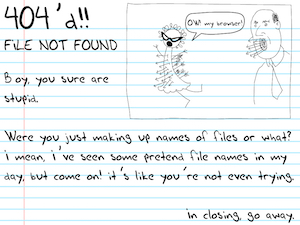“What goes on the Internet, stays on the Internet,” seems to be conventional wisdom these days. To quote the definitely not hysterical or hyperbolic headline used by the New York Times: “The Web Means the End of Forgetting.” Like much conventional wisdom, though, when you actually investigate them, these slogans turn out to be complete nonsense. The Internet is not some kind of perpetual memory machine. The “right to be forgotten” laws in the EU and the 1 million+ URLs Google has evaluated for removal over the past year alone are only the most visible tip of a vast subterranean system of digital decay. Consider all of the missing pages, broken links, and buggy websites that we encounter on a daily basis. Some of this misplaced material can be found with a few minutes of dedicated sleuthing, but a great deal of it will be lost forever. Consider all of the hand-wringing and discussions and lengthy policy studies within the digital humanities community over the issues of preservation and sustainability. If the Internet is forever, why is maintaining a digital project such a big problem?
 Online artifacts are a lot like biological organisms: they are born, they live, and they die. Even the terms used to describe their transmission, such as meme and “going viral,” draw on evolutionary theory. And in this new Darwinian frontier, survival is not automatic. The web is littered with half-finished, abandoned, lost, or outdated digital humanities projects. Part of the reason for this state of affairs is poor institutional support. IT departments are often loath to commit any resources to maintain sites or databases created by students and faculty. (I have encountered some pretty egregious examples of this.) And academic institutions have been slow to realize that support for digital projects is a core part of their basic educational mission. A handful of exceptional sites have endured, with strong institutional commitments. It took two years, a $100,000 grant, and a team of staff and student workers to resuscitate the Valley of the Shadow project, which ended in 2007. The Trans-Atlantic Slave Trade Database, which debuted in 2008, just won a major grant to recode the entire site and add new data and foreign language translations. Most projects are not so lucky. And when scholars are forced to trudge out on their own, with little or no long-term support structure, we all suffer.
Online artifacts are a lot like biological organisms: they are born, they live, and they die. Even the terms used to describe their transmission, such as meme and “going viral,” draw on evolutionary theory. And in this new Darwinian frontier, survival is not automatic. The web is littered with half-finished, abandoned, lost, or outdated digital humanities projects. Part of the reason for this state of affairs is poor institutional support. IT departments are often loath to commit any resources to maintain sites or databases created by students and faculty. (I have encountered some pretty egregious examples of this.) And academic institutions have been slow to realize that support for digital projects is a core part of their basic educational mission. A handful of exceptional sites have endured, with strong institutional commitments. It took two years, a $100,000 grant, and a team of staff and student workers to resuscitate the Valley of the Shadow project, which ended in 2007. The Trans-Atlantic Slave Trade Database, which debuted in 2008, just won a major grant to recode the entire site and add new data and foreign language translations. Most projects are not so lucky. And when scholars are forced to trudge out on their own, with little or no long-term support structure, we all suffer.
I had some fun with the problem of sustainability in my Digital History course last year. One of our core texts, Digital History: A Guide... by Dan Cohen and Roy Rosenzweig, has an entire chapter on preservation. Although the book itself is a decade old, the concepts and analysis remain remarkably fresh, and it is still a popular touchstone that is widely assigned in DH courses on the undergraduate and graduate level. Given the rapid pace of technological development, however, a new edition is badly needed. DH staples, such as Omeka and WordPress, or even Twitter and Wikipedia, were not yet on the radar when the book was published, and many of its examples are comically outdated. The authors spend several paragraphs discussing Jim Zwick’s famous website: “Anti-Imperialism in the United States, 1898–1935.” So I asked my students to evaluate the site for themselves. Of course, this was an impossible task, since the site no longer exists.
If done carefully and respectfully, I have found that tricking my students with phony texts or assignments like this can be both fun and enlightening. In this case, I offered to treat the entire class to an expensive meal if any one of them could find me a copy of Zwick’s site, in any format. Despite vigorous efforts on the Wayback Machine, Google, and even the Darknet, no one could find any trace of it. I gave them the entire semester to complete the challenge, and they still turned up nothing. Aside from a few tantalizing reviews, this huge, popular, exemplar DH project had been completely wiped from the face of the earth. Zwick’s death in 2008 means that the site, and all of its related data, guides, and analysis, will probably never return. At least in its original form, it has been lost forever. What goes on the Internet does not always stay on the Internet. (My students received a pizza lunch at the end of the semester anyway.)
 Another reason for the diminishing returns of existing DH projects is the publish-or-perish cult that dominates mainstream academic work. It is more advantageous to your CV, and way more exciting, to move on to a sexy new project than to spend all of your time and energy updating or preserving work that you did years ago. Although I try my best to maintain my legacy projects, I am as guilty of this as anyone. I did not update the underlying infrastructure or theme for this blog for years, and only did so recently because the server that hosted it was scheduled for demolition. Fortunately, Yale has committed to supporting my digital projects for the long haul, even after my graduation. They gave me a new domain for this site and an updated platform with admin privileges and server-side access. So I will be able to continue to maintain the site now that I have moved on to another position at some podunk school in New Jersey. I will be able to update the overall feel and UX for the site, make it more responsive and mobile friendly, and adapt to any new changes on the tech horizon. (A big shout out to Pam Patterson, Trip Kirkpatrick, and the rest of the ITG staff for offering a wonderful legacy support structure. I could not have kept this site alive without them.) Meanwhile, archived snapshots of earlier versions of the site are available on the Wayback Machine. Unfortunately, it is not a complete archive. Contrary to popular belief, not everything is automatically indexed by the Wayback Machine, or Google, or other similar services. When I realized this a few years ago, I had to go back and manually request the Machine to crawl and capture this site, page by page. If any folks out there know a better way to ensure that your site is archived on a comprehensive and regular basis, please get in touch.
Another reason for the diminishing returns of existing DH projects is the publish-or-perish cult that dominates mainstream academic work. It is more advantageous to your CV, and way more exciting, to move on to a sexy new project than to spend all of your time and energy updating or preserving work that you did years ago. Although I try my best to maintain my legacy projects, I am as guilty of this as anyone. I did not update the underlying infrastructure or theme for this blog for years, and only did so recently because the server that hosted it was scheduled for demolition. Fortunately, Yale has committed to supporting my digital projects for the long haul, even after my graduation. They gave me a new domain for this site and an updated platform with admin privileges and server-side access. So I will be able to continue to maintain the site now that I have moved on to another position at some podunk school in New Jersey. I will be able to update the overall feel and UX for the site, make it more responsive and mobile friendly, and adapt to any new changes on the tech horizon. (A big shout out to Pam Patterson, Trip Kirkpatrick, and the rest of the ITG staff for offering a wonderful legacy support structure. I could not have kept this site alive without them.) Meanwhile, archived snapshots of earlier versions of the site are available on the Wayback Machine. Unfortunately, it is not a complete archive. Contrary to popular belief, not everything is automatically indexed by the Wayback Machine, or Google, or other similar services. When I realized this a few years ago, I had to go back and manually request the Machine to crawl and capture this site, page by page. If any folks out there know a better way to ensure that your site is archived on a comprehensive and regular basis, please get in touch.
A post about preservation and sustainability seems like a fitting way to close out this blog (or at least this iteration of it). When I started this site about five years ago, I was one of maybe two or three grad students at my university who had any interest in digital tools and methodologies for research and teaching. There seemed to be a pressing need for a voice in the History Department, or in the humanities more generally, to raise the profile of DH work and show something of the potential and excitement of this new area of scholarship. Material on this blog has been featured on Digital Humanities Now, HASTAC, the Historical Society, and other places, and has hopefully contributed in some small way to that goal. This year, Yale launched a multi-million dollar Digital Humanities Lab, which has been many years in the making. Carol Chiodo, my co-blogger and longtime associate, is one of the founding staff members. I can’t really claim that this site contributed much to the establishment of the DH Lab at Yale, but I hope that it at least helped to add to the groundwork or general milieu that made the Lab a logical possibility. Certainly, the site has benefited my own career, building bridges to new topics, allowing me to meet new colleagues from all over the world, providing conference invites, interview requests, and job offers. It allowed me to preview some of my more serious scholarly work, or respond to pressing issues, or just vent some of my pent up silliness. Even if I do not have much time to continue to grow this site in the years ahead, I plan to keep it alive for as long as possible, and I promise to make sure that it is archived and accessible for future generations. Because in the rapidly evolving digital world, permanency is not something that can be taken for granted.